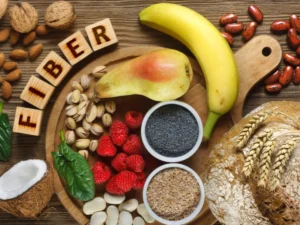Table of Contents
How Much Fiber Per Day? A Comprehensive Guide to Boosting Your Health
What Is Fiber and Why Is It Essential?
Fiber, also known as dietary fiber or roughage, is a plant-based nutrient crucial for maintaining overall health. Unlike other nutrients, fiber is not digested by the human body. Instead, it passes through the digestive system relatively intact, performing numerous beneficial roles along the way.
Despite its importance, an alarming 95% of Americans fail to meet the recommended daily fiber intake, according to the U.S. Department of Agriculture. This deficiency has led to fiber being classified as a “nutrient of public health concern.”
Fiber offers multiple health benefits, including improved digestion, weight management, cholesterol reduction, and blood sugar control. It also reduces the risk of chronic diseases such as heart disease, diabetes, and colon cancer.
Did you know? Low fiber intake is linked to higher cardiovascular risks in the U.S. compared to Mediterranean countries where fiber-rich diets are common.
How Much Fiber Per Day Do You Need?

How Much Fiber Per Day? Comprehensive Guide to Fiber Intake
General Recommendations
The amount of fiber you need daily varies based on factors such as age, sex, and health goals. Here are the recommended daily fiber intakes:
- Women (50 years or younger): 25–28 grams
- Men (50 years or younger): 31–38 grams
- Pregnant or lactating women: 28 grams
- Women (over 50 years): 21–22 grams
- Men (over 50 years): 28–30 grams
For children, the recommended daily intake ranges from 14 to 31 grams, depending on age and sex.
Special Considerations for Weight Loss
If your goal is weight loss, aim to meet or slightly exceed the daily minimum fiber requirement. Fiber helps you feel full longer, reducing overall calorie consumption. However, avoid exceeding 70 grams per day to prevent digestive discomfort.
Types of Fiber: Soluble vs. Insoluble
Understanding the Differences
Fiber comes in two primary forms:
- Soluble Fiber: Dissolves in water to form a gel-like substance. It helps lower cholesterol and blood sugar levels.
- Insoluble Fiber: Does not dissolve in water but adds bulk to stools, aiding in regular bowel movements.
Both types of fiber are essential and often found together in plant-based foods. For optimal health, aim for 6–8 grams of soluble fiber daily as part of your total fiber intake.
Top Sources of Fiber
High-fiber foods include:
- Vegetables (e.g., broccoli, carrots, spinach)
- Fruits (e.g., apples, pears, berries)
- Legumes (e.g., lentils, chickpeas, black beans)
- Nuts and seeds (e.g., almonds, chia seeds, flaxseeds)
- Whole grains (e.g., oats, brown rice, quinoa)
Incorporating a variety of these foods into your diet ensures you get both types of fiber and a range of other nutrients.
Meal Plan to Increase Fiber Intake
Boosting your fiber intake can be as simple as adjusting your daily meals. Here’s a sample high-fiber meal plan:
Sample Meal Plan
- Breakfast: Apple Cinnamon Oatmeal (8 grams)
- Snack: Greek yogurt with fresh raspberries (4 grams)
- Lunch: Lentil and Spinach Salad (10 grams)
- Snack: Carrot sticks with hummus (5–7 grams)
- Dinner: Grilled Salmon with Quinoa and Roasted Vegetables (10 grams)
By following this meal plan, you can easily consume 30–40 grams of fiber daily. Remember to stay hydrated, as water helps fiber move smoothly through your digestive system.
What Happens If You Eat Too Much Fiber?
While fiber is beneficial, excessive intake (over 70 grams per day) can lead to issues such as bloating, gas, and abdominal discomfort. Gradually increase your fiber consumption and drink plenty of water to minimize side effects.
Potential Side Effects
- Bloating and gas
- Constipation or diarrhea
- Abdominal pain
- Mineral absorption issues
- Rare cases of intestinal blockage
Speak with a healthcare professional if you’re concerned about your fiber intake, especially if you’re taking medications that may interact with a high-fiber diet.
Helpful Resources
For more detailed insights on fiber, check out these trusted resources: